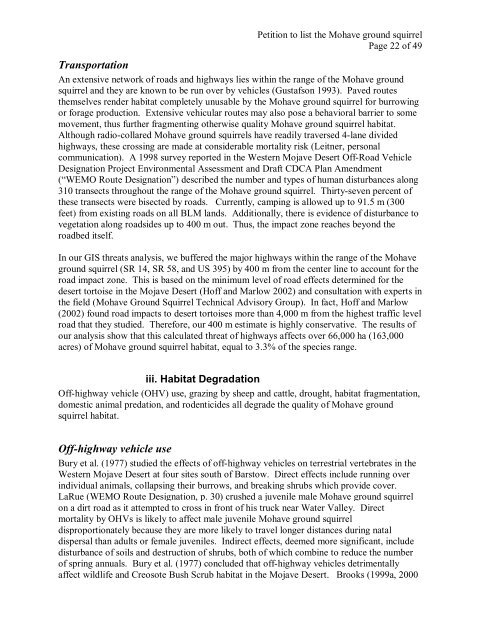Petition to list the Mohave Ground Squirrel - Defenders of Wildlife
Petition to list the Mohave Ground Squirrel - Defenders of Wildlife
Petition to list the Mohave Ground Squirrel - Defenders of Wildlife
You also want an ePaper? Increase the reach of your titles
YUMPU automatically turns print PDFs into web optimized ePapers that Google loves.
<strong>Petition</strong> <strong>to</strong> <strong>list</strong> <strong>the</strong> <strong>Mohave</strong> ground squirrel<br />
Page 22 <strong>of</strong> 49<br />
Transportation<br />
An extensive network <strong>of</strong> roads and highways lies within <strong>the</strong> range <strong>of</strong> <strong>the</strong> <strong>Mohave</strong> ground<br />
squirrel and <strong>the</strong>y are known <strong>to</strong> be run over by vehicles (Gustafson 1993). Paved routes<br />
<strong>the</strong>mselves render habitat completely unusable by <strong>the</strong> <strong>Mohave</strong> ground squirrel for burrowing<br />
or forage production. Extensive vehicular routes may also pose a behavioral barrier <strong>to</strong> some<br />
movement, thus fur<strong>the</strong>r fragmenting o<strong>the</strong>rwise quality <strong>Mohave</strong> ground squirrel habitat.<br />
Although radio-collared <strong>Mohave</strong> ground squirrels have readily traversed 4-lane divided<br />
highways, <strong>the</strong>se crossing are made at considerable mortality risk (Leitner, personal<br />
communication). A 1998 survey reported in <strong>the</strong> Western Mojave Desert Off-Road Vehicle<br />
Designation Project Environmental Assessment and Draft CDCA Plan Amendment<br />
(“WEMO Route Designation”) described <strong>the</strong> number and types <strong>of</strong> human disturbances along<br />
310 transects throughout <strong>the</strong> range <strong>of</strong> <strong>the</strong> <strong>Mohave</strong> ground squirrel. Thirty-seven percent <strong>of</strong><br />
<strong>the</strong>se transects were bisected by roads. Currently, camping is allowed up <strong>to</strong> 91.5 m (300<br />
feet) from existing roads on all BLM lands. Additionally, <strong>the</strong>re is evidence <strong>of</strong> disturbance <strong>to</strong><br />
vegetation along roadsides up <strong>to</strong> 400 m out. Thus, <strong>the</strong> impact zone reaches beyond <strong>the</strong><br />
roadbed itself.<br />
In our GIS threats analysis, we buffered <strong>the</strong> major highways within <strong>the</strong> range <strong>of</strong> <strong>the</strong> <strong>Mohave</strong><br />
ground squirrel (SR 14, SR 58, and US 395) by 400 m from <strong>the</strong> center line <strong>to</strong> account for <strong>the</strong><br />
road impact zone. This is based on <strong>the</strong> minimum level <strong>of</strong> road effects determined for <strong>the</strong><br />
desert <strong>to</strong>r<strong>to</strong>ise in <strong>the</strong> Mojave Desert (H<strong>of</strong>f and Marlow 2002) and consultation with experts in<br />
<strong>the</strong> field (<strong>Mohave</strong> <strong>Ground</strong> <strong>Squirrel</strong> Technical Advisory Group). In fact, H<strong>of</strong>f and Marlow<br />
(2002) found road impacts <strong>to</strong> desert <strong>to</strong>r<strong>to</strong>ises more than 4,000 m from <strong>the</strong> highest traffic level<br />
road that <strong>the</strong>y studied. Therefore, our 400 m estimate is highly conservative. The results <strong>of</strong><br />
our analysis show that this calculated threat <strong>of</strong> highways affects over 66,000 ha (163,000<br />
acres) <strong>of</strong> <strong>Mohave</strong> ground squirrel habitat, equal <strong>to</strong> 3.3% <strong>of</strong> <strong>the</strong> species range.<br />
iii. Habitat Degradation<br />
Off-highway vehicle (OHV) use, grazing by sheep and cattle, drought, habitat fragmentation,<br />
domestic animal predation, and rodenticides all degrade <strong>the</strong> quality <strong>of</strong> <strong>Mohave</strong> ground<br />
squirrel habitat.<br />
Off-highway vehicle use<br />
Bury et al. (1977) studied <strong>the</strong> effects <strong>of</strong> <strong>of</strong>f-highway vehicles on terrestrial vertebrates in <strong>the</strong><br />
Western Mojave Desert at four sites south <strong>of</strong> Bars<strong>to</strong>w. Direct effects include running over<br />
individual animals, collapsing <strong>the</strong>ir burrows, and breaking shrubs which provide cover.<br />
LaRue (WEMO Route Designation, p. 30) crushed a juvenile male <strong>Mohave</strong> ground squirrel<br />
on a dirt road as it attempted <strong>to</strong> cross in front <strong>of</strong> his truck near Water Valley. Direct<br />
mortality by OHVs is likely <strong>to</strong> affect male juvenile <strong>Mohave</strong> ground squirrel<br />
disproportionately because <strong>the</strong>y are more likely <strong>to</strong> travel longer distances during natal<br />
dispersal than adults or female juveniles. Indirect effects, deemed more significant, include<br />
disturbance <strong>of</strong> soils and destruction <strong>of</strong> shrubs, both <strong>of</strong> which combine <strong>to</strong> reduce <strong>the</strong> number<br />
<strong>of</strong> spring annuals. Bury et al. (1977) concluded that <strong>of</strong>f-highway vehicles detrimentally<br />
affect wildlife and Creosote Bush Scrub habitat in <strong>the</strong> Mojave Desert. Brooks (1999a, 2000
















